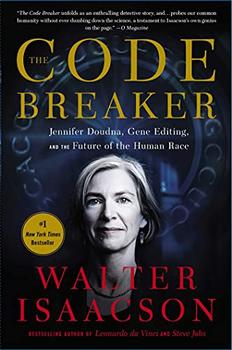Summary | Excerpt | Reviews | Beyond the Book | Readalikes | Genres & Themes | Author Bio

Jennifer Doudna, Gene Editing, and the Future of the Human Race
by Walter Isaacson
The second half of the twentieth century was an information-technology era, based on the idea that all information could be encoded by binary digits—known as bits—and all logical processes could be performed by circuits with on-off switches. In the 1950s, this led to the development of the microchip, the computer, and the internet. When these three innovations were combined, the digital revolution was born.
Now we have entered a third and even more momentous era, a life-science revolution. Children who study digital coding will be joined by those who study genetic code.
When Doudna was a graduate student in the 1990s, other biologists were racing to map the genes that are coded by our DNA. But she became more interested in DNA's less-celebrated sibling, RNA. It's the molecule that actually does the work in a cell by copying some of the instructions coded by the DNA and using them to build proteins. Her quest to understand RNA led her to that most fundamental question: How did life begin? She studied RNA molecules that could replicate themselves, which raised the possibility that in the stew of chemicals on this planet four billion years ago they started to reproduce even before DNA came into being.
As a biochemist at Berkeley studying the molecules of life, she focused on figuring out their structure. If you're a detective, the most basic clues in a biological whodunit come from discovering how a molecule's twists and folds determine the way it interacts with other molecules. In Doudna's case, that meant studying the structure of RNA. It was an echo of the work Rosalind Franklin had done with DNA, which was used by James Watson and Francis Crick to discover the double-helix structure of DNA in 1953. As it happens, Watson, a complex figure, would weave in and out of Doudna's life.
Doudna's expertise in RNA led to a call from a biologist at Berkeley who was studying the CRISPR system that bacteria developed in their battle against viruses. Like a lot of basic science discoveries, it turned out to have practical applications. Some were rather ordinary, such as protecting the bacteria in yogurt cultures. But in 2012 Doudna and others figured out a more earth-shattering use: how to turn CRISPR into a tool to edit genes.
CRISPR is now being used to treat sickle-cell anemia, cancers, and blindness. And in 2020, Doudna and her teams began exploring how CRISPR could detect and destroy the coronavirus. "CRISPR evolved in bacteria because of their long-running war against viruses," Doudna says. "We humans don't have time to wait for our own cells to evolve natural resistance to this virus, so we have to use our ingenuity to do that. Isn't it fitting that one of the tools is this ancient bacterial immune system called CRISPR? Nature is beautiful that way." Ah, yes. Remember that phrase: Nature is beautiful. That's another theme of this book.
There are other star players in the field of gene editing. Most of them deserve to be the focus of biographies or perhaps even movies. (The elevator pitch: A Beautiful Mind meets Jurassic Park.) They play important roles in this book, because I want to show that science is a team sport. But I also want to show the impact that a persistent, sharply inquisitive, stubborn, and edgily competitive player can have. With a smile that sometimes (but not always) masks the wariness in her eyes, Jennifer Doudna turned out to be a great central character. She has the instincts to be collaborative, as any scientist must, but ingrained in her character is a competitive streak, which most great innovators have. With her emotions usually carefully controlled, she wears her star status lightly.
Her life story—as a researcher, Nobel Prize winner, and public policy thinker—connects the CRISPR tale to some larger historical threads, including the role of women in science. Her work also illustrates, as Leonardo da Vinci's did, that the key to innovation is connecting a curiosity about basic science to the practical work of devising tools that can be applied to our lives—moving discoveries from lab bench to bedside.
Excerpted from The Code Breaker by Walter Isaacson. Copyright © 2021 by Walter Isaacson. Excerpted by permission of Simon & Schuster. All rights reserved. No part of this excerpt may be reproduced or reprinted without permission in writing from the publisher.
Your guide toexceptional books
BookBrowse seeks out and recommends the best in contemporary fiction and nonfiction—books that not only engage and entertain but also deepen our understanding of ourselves and the world around us.